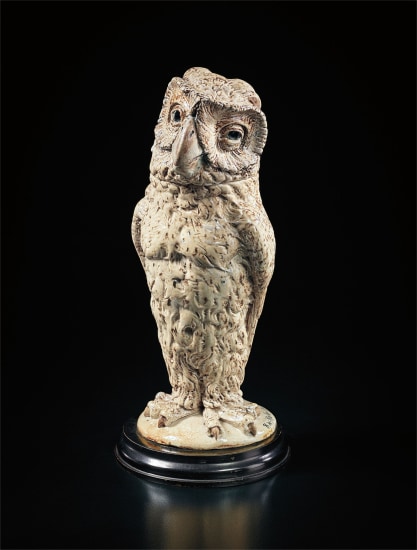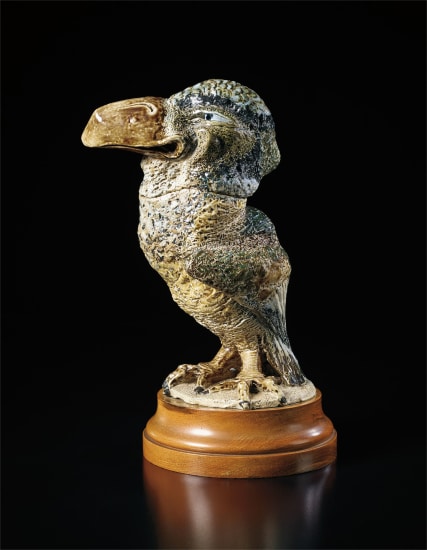Property from a Private Collection R. W. Martin & Brothers Follow Exceptional and monumental mantel clock case January 1878 Salt-glazed stoneware. 28 1/2 in. (72.5 cm) high Reverse incised R Wallace Martin/Southall/Middlesex/1-1878 and 70, and interior clock face incised R W Martin/Southall/12 1878.
Provenance Sotheby & Co., London, “Nineteenth and Twentieth Century English, Continental and Oriental Ceramics and Works of Art,” June 15, 1971, lot 86 Roy Aitken, Esq. Sotheby’s Belgravia, “A Large Collection of Martin Brothers Stoneware: The Property of Roy Aitken, Esq.,” April 19, 1978, lot 20 Richard Dennis, London John S. M. Scott, Esq., London, 1978 The Fine Art Society, London Sinai and Sons, London, 2014 Acquired from the above Exhibited "The Martin Brothers Potters," Sotheby's Belgravia, London, September 16–October 14, 1978 “The John Scott Collection: Decorative Arts from the Nineteenth and early Twentieth Centuries,” The Fine Art Society, London, June 11–20, 2014 Literature The Martin Brothers Potters, exh. cat., Sotheby's Belgravia, London, 1978, p. 5, no. 81 Malcolm Haslam, The Martin Brothers Potters, London, 1978, illustrated p. 12 The John Scott Collection: British Art Pottery, Volume 3, exh. cat., The Fine Art Society, London, 2014, illustrated p. 26 Catalogue Essay Diversity and Intensity by Malcolm Haslam All pieces of pottery made by the Martin brothers are distinctive, most are excellent, some outstanding. The four pieces on offer here are the crème de la crème. They all owe much of their brilliance to the genius of Robert Wallace Martin (1843-1924), the eldest of the four brothers, the founder of the pottery, and an artistic talent to rival any other Victorian sculptor. His eccentric imagination, combined with mental determination and prodigious manual skill, created an œuvre which is awesome, both in its diversity and its intensity. These four pieces represent a microcosm of that diversity. The clock case is architectural, a functional object, decorated with mostly flat pattern. Then there are the two birds, slyly humorous, pretending to be tobacco-jars but patently impractical as such. At several further degrees of remoteness from the utility of the clock case, comes the crab with a human face, a surreal monster which is totally non-functional, pure sculpture created to amuse but also to terrify. It is this diversity of style which has drawn in over the years so many collectors who themselves, perhaps, have only one thing in common—an aesthetic appreciation beyond the conventional. The intensity of Wallace's creations is revealed in each of these four pieces. A dramatic intensity is achieved not only through the sheer scale of the clock case, but also through the density of its ornament. The bird made in 1883 also impresses through its size; it wears an expression so intensely human, yet remains so irrefutably avian, that one is forced to laugh without being quite sure what one is laughing at, which is the essence of true humor. The caricature of Sir Edward Clarke regards you with such an intensely inquisitorial eye that one feels oneself quaking in the witness box before a barrage of searching questions, only able to give a series of contradictory answers. The crab is, quite simply, intensity itself, realized in stoneware; the reality of its intensity seems to be almost the only thing about the creature which is real. To create such a monster takes the extreme imagination that its maker possessed—or, rather, which possessed its maker. Between them the four pieces reveal two primary sources of influence which helped to mold Wallace's imagination. Like so many minds, then and now, his fell under the spell of Christopher Dresser's ideas. Wallace was precisely the sort of under-privileged art-worker at whom Dresser aimed his writings; Principles of Decorative Design (1873) was based on a series of lectures which Dresser had "prepared especially for those noble fellows who, through want of opportunity, have been without the advantages of education, but who have the praiseworthy courage to educate themselves in later life, when the value of knowledge has become apparent to them.” He adopted two slogans, “Knowledge is Power” and “Truth, Beauty, Power,” and his insistence on power as an important ingredient of
Property from a Private Collection R. W. Martin & Brothers Follow Exceptional and monumental mantel clock case January 1878 Salt-glazed stoneware. 28 1/2 in. (72.5 cm) high Reverse incised R Wallace Martin/Southall/Middlesex/1-1878 and 70, and interior clock face incised R W Martin/Southall/12 1878.
Provenance Sotheby & Co., London, “Nineteenth and Twentieth Century English, Continental and Oriental Ceramics and Works of Art,” June 15, 1971, lot 86 Roy Aitken, Esq. Sotheby’s Belgravia, “A Large Collection of Martin Brothers Stoneware: The Property of Roy Aitken, Esq.,” April 19, 1978, lot 20 Richard Dennis, London John S. M. Scott, Esq., London, 1978 The Fine Art Society, London Sinai and Sons, London, 2014 Acquired from the above Exhibited "The Martin Brothers Potters," Sotheby's Belgravia, London, September 16–October 14, 1978 “The John Scott Collection: Decorative Arts from the Nineteenth and early Twentieth Centuries,” The Fine Art Society, London, June 11–20, 2014 Literature The Martin Brothers Potters, exh. cat., Sotheby's Belgravia, London, 1978, p. 5, no. 81 Malcolm Haslam, The Martin Brothers Potters, London, 1978, illustrated p. 12 The John Scott Collection: British Art Pottery, Volume 3, exh. cat., The Fine Art Society, London, 2014, illustrated p. 26 Catalogue Essay Diversity and Intensity by Malcolm Haslam All pieces of pottery made by the Martin brothers are distinctive, most are excellent, some outstanding. The four pieces on offer here are the crème de la crème. They all owe much of their brilliance to the genius of Robert Wallace Martin (1843-1924), the eldest of the four brothers, the founder of the pottery, and an artistic talent to rival any other Victorian sculptor. His eccentric imagination, combined with mental determination and prodigious manual skill, created an œuvre which is awesome, both in its diversity and its intensity. These four pieces represent a microcosm of that diversity. The clock case is architectural, a functional object, decorated with mostly flat pattern. Then there are the two birds, slyly humorous, pretending to be tobacco-jars but patently impractical as such. At several further degrees of remoteness from the utility of the clock case, comes the crab with a human face, a surreal monster which is totally non-functional, pure sculpture created to amuse but also to terrify. It is this diversity of style which has drawn in over the years so many collectors who themselves, perhaps, have only one thing in common—an aesthetic appreciation beyond the conventional. The intensity of Wallace's creations is revealed in each of these four pieces. A dramatic intensity is achieved not only through the sheer scale of the clock case, but also through the density of its ornament. The bird made in 1883 also impresses through its size; it wears an expression so intensely human, yet remains so irrefutably avian, that one is forced to laugh without being quite sure what one is laughing at, which is the essence of true humor. The caricature of Sir Edward Clarke regards you with such an intensely inquisitorial eye that one feels oneself quaking in the witness box before a barrage of searching questions, only able to give a series of contradictory answers. The crab is, quite simply, intensity itself, realized in stoneware; the reality of its intensity seems to be almost the only thing about the creature which is real. To create such a monster takes the extreme imagination that its maker possessed—or, rather, which possessed its maker. Between them the four pieces reveal two primary sources of influence which helped to mold Wallace's imagination. Like so many minds, then and now, his fell under the spell of Christopher Dresser's ideas. Wallace was precisely the sort of under-privileged art-worker at whom Dresser aimed his writings; Principles of Decorative Design (1873) was based on a series of lectures which Dresser had "prepared especially for those noble fellows who, through want of opportunity, have been without the advantages of education, but who have the praiseworthy courage to educate themselves in later life, when the value of knowledge has become apparent to them.” He adopted two slogans, “Knowledge is Power” and “Truth, Beauty, Power,” and his insistence on power as an important ingredient of















Testen Sie LotSearch und seine Premium-Features 7 Tage - ohne Kosten!
Lassen Sie sich automatisch über neue Objekte in kommenden Auktionen benachrichtigen.
Suchauftrag anlegen